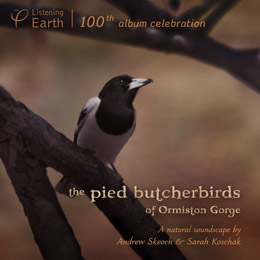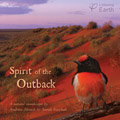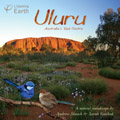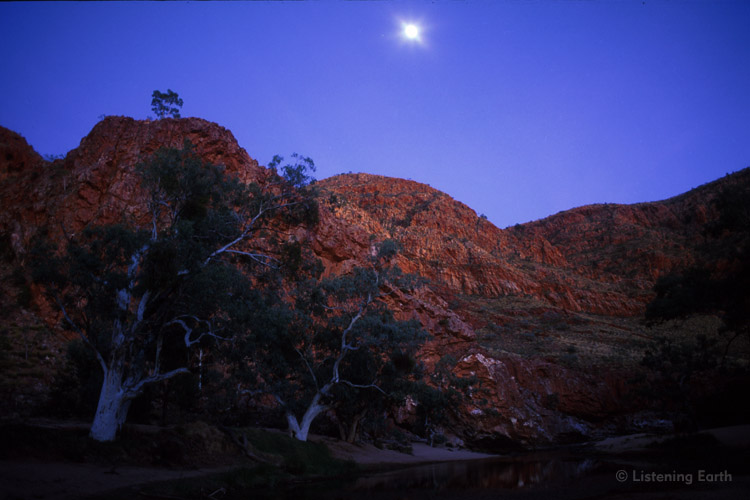

Running Time:
86 min
Release Date:
February 2019
Recording Location:
1. Mutawintji (Mootwingee) National Park, western NSW
2 & 3. Ormiston Gorge, western MacDonnell Ranges, Northern Territory
If you like this album,
we also recommend:
The Pied Butcherbirds of Ormiston Gorge
This album is our 100th Listening Earth release, and to celebrate this milestone, we're returning to one of our most evocative field recordings from the last 25 years.
In the small hours of the morning, a full moon illuminates a large waterhole at the entrance to Ormiston Gorge. The landscape all around is epic and ancient; massive quartzite rock walls are silhouetted above sandy banks of a waterhole lined with pale-barked gum trees.
This permanent water is a haven for wildlife, and here we listen into the night. A gentle breeze occasionally whispers through the leaves of the old ghost gums, while crickets chirrup from fringing reedbeds.
Subtle sounds come from all around, but the mesmerising focus is a Pied Butcherbird. It roosts unseen in a tree opposite, singing gracefully. The song of the Pied Butcherbird is renowned as being among the most musical in the avian world. But now, in the depths of the night, this bird is singing slowly, serenely, languidly, as though half asleep. And in this place, surrounded by an amphitheatre of rock, its voice echoes - one of nature's most sublime songs in a natural cathedral.
The Butcherbird is the nocturnal deva, however there is a whole outback ecosystem to be heard. Desert Tree Frogs chorus from the far end of the waterhole, a White-sided Freetail Bat hawks for insects overhead, and a Barn Owl screeches while flying past in the dark. On the water, a pair of Grebes float quietly, every now and then giving soft chattering calls.
The following evening we return to the same place to listen again, but this night our Butcherbird has roosted elsewhere, and its song echoes eerily from further up the gorge. Yet it is every bit as beautiful as previously. Meanwhile Rock Wallabies feed and move around the nearby rock slopes, occasionally dislodging stones or thumping noisily. A pair of Black-fronted Dotterels take flight and begin a raspy calling on the wing as they circle back and forth over the water.
These recordings are the complete sequences, remastered from our original field tapes.
Andrew comments:
"These recordings were made in 1998, and at the time I felt they were magical. Edited versions of the two evenings became the first and last tracks of our 'Spirit of the Outback' album.
"Since then, numerous people have commented that the Ormiston Butcherbird is a standout recording for them. I have played it at many lectures, and featured it in the beginning of my TedX talk. I've analysed the repertoire of this particular bird in terms of its phrase structure and sequencing. The British composer, Mark de Brito, used the recording as the basis of a solo piano composition.
"Recently, Hollis Taylor, a musician and recordist who's PhD research, book and CD of original compositions explores the aesthetics of Butcherbird song, has told me that despite many visits to Ormiston over the years, she has never heard them sing there as we did those evenings. So it seems this recording is not only beautiful, but documents a truly serendipitous event.
"For this album, we've chosen to complement the Ormiston recordings with one of our first nature recordings from 1993, and the one that really inspired me to become a field recordist.
"It is another outback recording, from Mutawintji in western NSW, of Spiney-cheeked Honeyeaters singing at dawn.
"We were at Mutawintji to record music for an early project that became 'Rockpool Reflections'. Capturing environmental ambiences was part of the project, but not something I'd done before. At the time I had only borrowed equipment, and was teaching myself how to work with the microphones.
"The experience of hearing these Spineys singing hauntingly in the first light of day was a revelation to me. Despite a childhood fascination with birds in the Sydney bush where I'd grown up, I'd never heard this species, and realised I'd not taken much notice of birdsong. It felt to me that I was hearing for the first time; more than just birdsong, I was hearing the landscape giving voice to itself.
"It was a formative step in the Listening Earth story, yet only a small sequence from the recording has so far seen the light of day. As with the Ormiston recordings, I've returned to the original field tapes, and remastered the complete sequence.
"As I listen back over 25 years, I can remember my younger self standing in the dark, enthralled by what he was hearing, and hoping the recorder was working!"
Audio sample of this album
|
1. |
1993: Spiney-cheeked Honeyeater Dawn Chorus, Mutawintji |
13.49 |
|
2. |
1998: Pied Butcherbirds, Ormiston Gorge, 3 a.m., Full Moon |
20.47 |
|
3. |
1998: Pied Butcherbirds, Ormiston Gorge, The Following Evening |
51.49 |
Purchase this
album as:
Digital Album
(for immediate download)
Download this album
for as little as
$7.50 -
View Special Deals
(Prices AU$, exGST)
Mp3:
Mp3 is a universal audio format, playable on iPods, computers, media players and mobile phones.
Mp3 is a compressed format, allowing smaller filesizes, offering faster download times and requiring less storage space on players, but at some expense to the audio quality. Many listeners can't really hear the difference between mp3 and full CD-quality audio, and hence its convenience has lead to it becoming the default option for audio.
Our albums are generally encoded at around 256kbps (sometimes with VBR), balancing optimal audio quality without blowing out filesizes excessively. We encode using the Fraunhoffer algorithm, which preserves more detail in the human audible range than the lame encoder.
Our mp3 files are free of any DRM (digital rights management), so you can transfer them to any of your media technology. You've paid for them, they're yours for your personal use without restriction.
Mp3 files can be burned to disc, either as an mp3 disc, or an audio CD after converting them to a standard audio (.wav or .aif) format first.
FLAC:
FLAC is a high-quality audio format, allowing CD-resolution audio. It is ideal if you wish to burn your files to a CDR, or listen over a high resolution audio system. However files usually require special decoding by the user before playing or burning to disc.
FLAC (Free Lossless Audio Codec) is a LOSSLESS compressed audio format. This means that it preserves the full audio quality of a CD, but optimises the filesize for downloading. Typically, file sizes of around 60% are achieved without any degradation or loss of audio quality from the source files at the CD standard of 16bit/44.1kHz.
Obviously the file sizes are larger than for the mp3 version - usually around 300-400Mb for an album, compared to 100Mb for an mp3 album.
In addition, you'll need to know what to do with the files once you've downloaded them. In most cases you'll want to decode the files to wav or aiff, either to import into programs like iTunes, or burn to CDR. Some programs will play flac files natively.
There is a lot of information about flac online (eg: http://flac.sourceforge.net/)





 Alternate audio link
Alternate audio link 